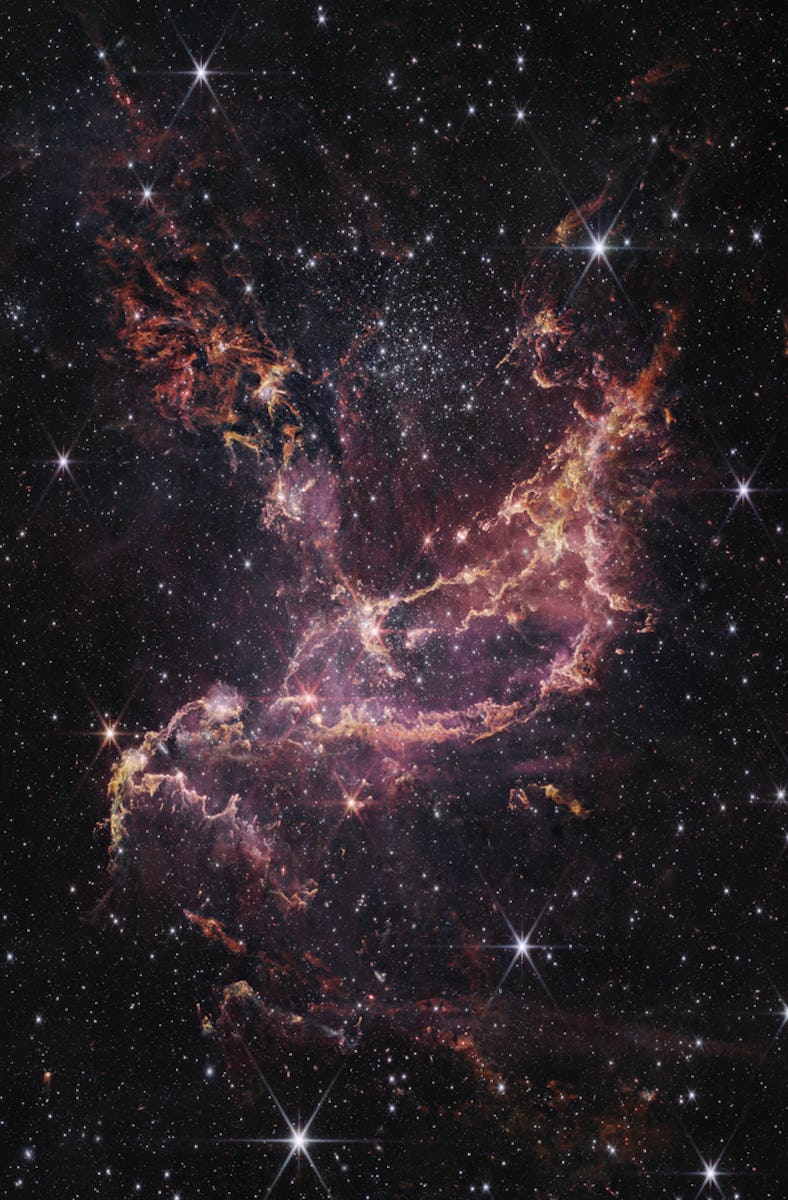A Tiny Nearby Galaxy Has More Planet-Building Potential Than We Thought
Surprise leftover dust in a nearby tiny galaxy suggests early galaxies may have had more planet-making ingredients than we thought.

A stellar nursery in the Small Magellanic Cloud — a tiny galaxy that orbits our Milky Way — is surprisingly dusty.
All rocky planets start as dust grains floating in space. That means the amount of dust orbiting a newborn star is a big clue about how much planet-forming might happen in the new star system. And the surprising amount of dust shrouding newborn stars in the Small Magellanic could be a hint that billions of years ago, in the universe’s ancient past, rocky planets formed more often than astronomers expected.
The astronomers published their work in a recent paper in the journal Nature Astronomy.
Tiny Galaxy Makes Stars with Dust to Spare
Astronomer Olivia Jones (of the Royal Observatory in the UK) and her colleagues recently used JWST’s Near Infrared Camera (NIRCam) instrument to take a census of the stars in a specific area of the Small Magellanic Cloud: a nebula called NGC 346.
About 300 of the stars they spotted were smallish stars, just a few times the mass of our Sun, and so young that their thermonuclear hearts had only just flared to life. Thick envelopes of dust still surrounded these young stars, which made them perfect targets for infrared imaging; dust tends to block shorter wavelengths of light, including the ones our eyes can see, but the long wavelengths of infrared can see into and through dust clouds easily.
NIRCam captured this image of NGC 346, a busy star-forming region in the Small Magellanic Cloud.
But the dust was a surprise to Jones and her colleagues. The Small Magellanic Cloud has a distinct shortage of some of the ingredients needed to make dust: metals like silicon, magnesium, and iron. In fact, the dwarf galaxy’s composition is pretty similar to that of much more distant galaxies — ones that date back to around 11 billion years ago.
In galaxies so short on metals, it seemed likely that once stars formed (gobbling up some dust in the process), there wouldn’t be enough dust — or dust ingredients — left to form rocky planets. The amount of dust Jones and her colleagues spotted around young, smallish stars in NGC 346 suggests otherwise, though. It’s evidence that rocky planets actually can form in galaxies with much less metal in their makeup than our Milky Way – and could have formed in galaxies in our Universe’s distant past.
“Given that planet formation is likely in the Small Magellanic Cloud, the authors infer that planets may have been able to form during this time period,” write Jones and her colleagues in their recent paper.
In other words, rocky planets may have been a common feature of our Universe much earlier than astronomers previously thought was possible.
Dust is a Must
That means that both dust and rocky planets may be more common in the universe than previously thought. And that matters because some of the key ingredients for life — from water and other ices to building blocks like the nucleotide uracil and the material cell membranes are made of — form on the surfaces of dust grains in interstellar space. If you want planets at all, but especially if you want habitable planets, dust is a must.
Finding dust in a metal-poor galaxy like the Small Magellanic Cloud means that the conditions for having dust, and all the things dust enables, aren’t limited to big, resource-rich galaxies like our Milky Way. This means that ultimately, the conditions for life might not be so limited, either.
Inside A “Living” Cosmic Fossil
The nebula NGC 346 is one of the most active star-forming regions in the entire Local Group, which includes our Milky Way along with the Andromeda and Triangulum Galaxies, and a host of little dwarf galaxies like the Small Magellanic Cloud. That’s pretty impressive given that the Small Magellanic Cloud is — well, small.
Overall, the source material from which these stars coalesce is, like everything in space, mostly hydrogen with a smattering of other elements. But that smattering of other elements includes only about 20 percent as much of metals like silicon (a key ingredient in Earth’s crust and that of other rocky planets) as our Milky Way. Astronomers have measured a similar ratio of elements in the spectra of galaxies from a period called Cosmic Noon — a phase of intensely rapid star formation that lit up the young universe around 11 billion years ago. Most of the stars and black holes that now exist formed during Cosmic Noon (although obviously many have also formed since). That universe-wide flurry of star formation is also pretty similar to what’s happening right now in NGC 346.
In other words, astronomers can draw some conclusions about what happened in those ancient, Cosmic Noon galaxies based on what goes on in the busy nearby nebula 200,000 light years away. And what’s going on, it turns out, may involve a surprising amount of dust and planet formation.
This article was originally published on